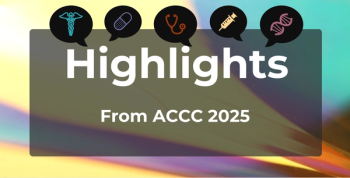
TRANSFORM-2 Results on Esketamine Published, Along With Caveats
The American Journal of Psychiatry published one of the studies that led to approval of one of the most anticipated therapies in years: esketamine for treatment-resistant depression.
Full results from TRANSFORM-2, a phase 3 trial that led to the
It’s clear from both papers that this is no ordinary drug, one that will demand careful management from clinicians and cooperation from payers—based on reports, interruptions in coverage could have significant consequences.
At a media briefing during the 175th Annual Meeting of the American Psychiatric Association in San Francisco, California, both study co-author Michael E. Thase, MD, and commentary author Alan F. Schatzberg, MD, agreed that esketamine addresses an unmet need—it’s intended for the estimated 30% of patients with major depressive disorder who have tried other antidepressants, but they simply haven't worked.
TRD “is the greatest cause of disability in the United States,” said Thase, of the Perelman School of Medicine at the University of Pennsylvania. “Each time a treatment doesn’t work, that’s a marriage that might fall apart, a person who’s about to lose a job, someone who’s not there to parent a child.”
“We deal with desperate people every day,” said Schatzberg, of Stanford University School of Medicine, as he described the severely depressed person as “slogging through life, not having any pleasure.”
The difference with esketamine—the new version is delivered through an intranasal spray instead of intravenous (IV) ketamine infusions—is that it takes effect within 24 to 48 hours, so patients have immediate relief instead of waiting weeks or months to feel better. But like the IV version, the nasal spray must be administered in a doctor’s office, because it can temporarily leave patients with nausea, dizziness, and feelings of disassociation. Patients are not advised to work for the rest of the day after taking the dose, Thase said.
He explained how the effects of ketamine, an anesthetic and NMDA receptor antagonist, were discovered by accident, and its effects were not initially taken seriously. Esketamine, the S-enantiomer of ketamine racemate, was found to have a higher affinity for the NMDA receptor than the R-enantiomer.
In the phase 3 trial published Tuesday, 435 patients were screened, 277 underwent randomization, and 197 completed the 28-day double-blind treatment phase. Thase explained that FDA required that participants start both a new standard-of-care anti-depressant, plus either esketamine or placebo.
The change in the Montgomery—Åsberg Depression Rating Scale (MADRS) diagnostic questionnaire, used to rate the severity of mood disorders, at the 28-day mark was a –4.0 (SE, 1.69; 95% CI, –7.31 to –0.64). Thase said while this may seem moderate, “a 4-point difference when 20% of the people are meaningfully better—that saves lives.”
In TRANSFORM-2, dosing of esketamine was done for 4 weeks, with 24 weeks follow-up. Schatzberg noted that this study was one of 3 pivotal trials, but the only one that resulted in statistically significant separation from placebo on the primary end point. FDA relied on a drug relapse/discontinuation trial in the approval process, which he wrote is a “somewhat unusual” path to approval.
Schatzberg said ketamine has been has been shown to have opioid properties and has been abused outside of clinical settings, which the medical community must take seriously. More studies are needed to fully understand these properties, he said.
While esketamine is milder, and easier to administer, Schatzberg warns there are many questions; coming off the drug in particular seems to be an issue. His commentary discusses relapse rates with less frequent administration and asks whether FDA erred when it did not attribute 3 suicides as drug-related, even though they occurred soon after withdrawal from esketamine.
Given the possible issues with sudden, unplanned withdrawal from the drug, The American Journal of Managed Care® asked Thase what extra steps clinicians should take to ensure there are no interruptions in coverage. Thase said thus far, he has experienced good payer coverage but that he had prepared his institution for the arrival of esketamine well in advance.
“As a clinician, it is really good to see someone respond within the first few days of treatment,” he said. “If someone doesn’t get that early improvement, I can shut it down.”
Thus far, there are no biomarkers for who will succeed on the drug, but there does seem to be a link with a family history of alcoholism, the physicians said.
Janssen Pharmaceuticals released the following statement about the article, “Until the recent FDA approval of SPRAVATO™ (esketamine) CIII nasal spray, the first new mechanism of action for an antidepressant medication in decades, healthcare providers have had limited options for adult patients with treatment-resistant depression. These findings, which represent part of the Phase 3 clinical trial program of more than 1700 patients, reinforce the robust efficacy and safety profile of the medicine and the significant improvement of depression symptoms that Spravato may offer adults with TRD.”
On balance, Schatzberg wrote that suffering patients need solutions. “Taken together, there are more questions than answers with intranasal esketamine, and care should be exercised in its application in clinical practice,” he writes. “Only time will tell how useful it will be. Still, the agent could be helpful to many patients with refractory depression, and efforts to develop rapidly acting agents for severely depressed patients need to be applauded.”
References
1. Popova V, Daly EJ, Trivedi M, et al. Efficacy and safety of flexibly dosed esketamine nasal spray combined with a newly initiated oral antidepressant in treatment resistant depression; a randomized double-blind active-controlled study [published May 20, 2019]. Am J Psychiatry. doi: 10.1176/appi.ajp.2019.19020172.
2. Schatzberg AF. A word to the wise about intranasal esketamine. Am J Psychiatry. 2019.
Newsletter
Stay ahead of policy, cost, and value—subscribe to AJMC for expert insights at the intersection of clinical care and health economics.












































